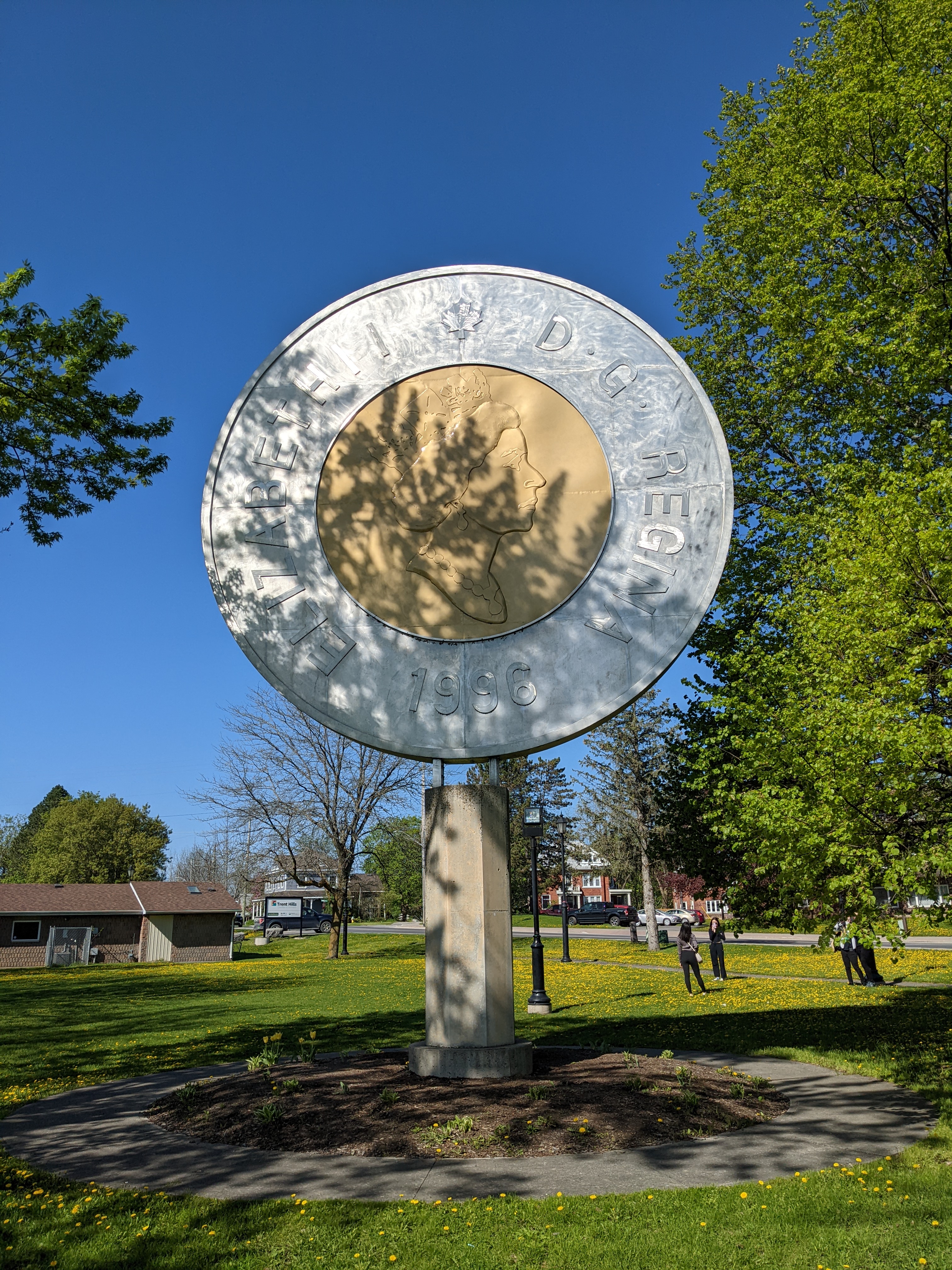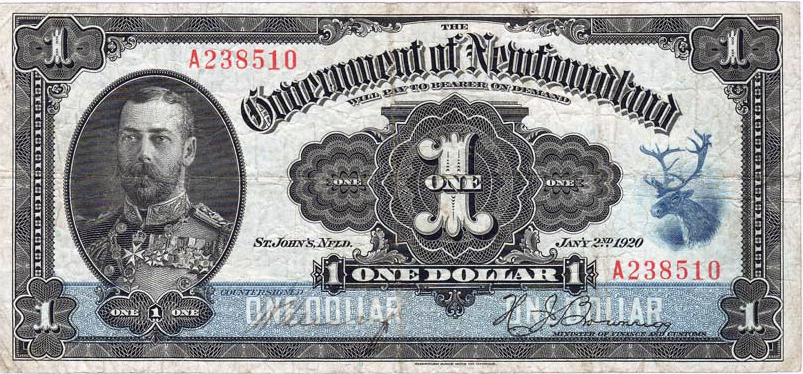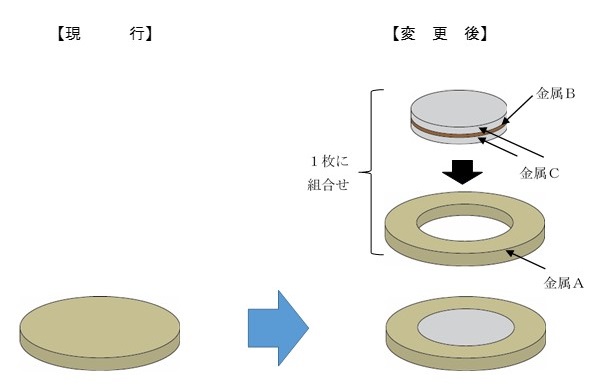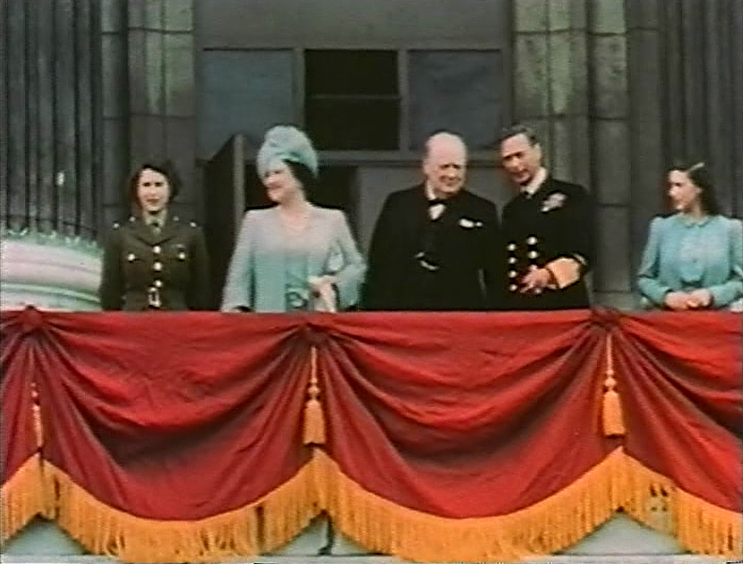|
Toonie
The toonie (also spelled twonie or twoonie), formally the Canadian two-dollar coin (, nicknamed or ), was introduced on February 19, 1996, by Minister of Public Works Diane Marleau. , it possesses the highest monetary value of any circulating Canadian coin. The toonie is a bi-metallic coin which on the reverse side bears an image of a polar bear by artist Brent Townsend. The obverse, like all other current Canadian circulation coins, has a portrait of Queen Elizabeth II. It has the words in a typeface different from any other Canadian coin. The coin is manufactured using a patented distinctive bi-metallic coin-locking mechanism. The coins are estimated to last 20 years. The discontinued two-dollar bill was less expensive to manufacture but lasted only one year on average. On April 10, 2012, the Royal Canadian Mint (RCM) announced design changes to the loonie and toonie, which include new security features. Coins minted prior to 2012 consist of an aluminum bronze inn ... [...More Info...] [...Related Items...] OR: [Wikipedia] [Google] [Baidu] |
Coins Of The Canadian Dollar
The coins of Canada are produced by the Royal Canadian Mint and denominated in Canadian dollars ($) and the subunit of dollars, cent (currency), cents (¢). An effigy of the reigning monarch always appears on the obverse of all coins. There are standard images which appear on the reverse, but there are also commemorative and Royal Canadian Mint numismatic coins (20th century), numismatic issues with different images on the reverse. Circulation denominations There are six denominations of Canadian circulation coinage in production: 5¢, 10¢, 25¢, 50¢, $1, and $2. Officially they are each named according to their value (e.g. "10-cent piece"), but in practice only the 50-cent piece (Canadian coin), 50-cent piece is known by that name. The three smallest coins are known by the traditional names "nickel" (5¢), "dime" (10¢), and "quarter" (25¢), and the one-dollar and two-dollar coins are called the "loonie" (for the loon depiction on the Obverse and reverse, reverse) and the "to ... [...More Info...] [...Related Items...] OR: [Wikipedia] [Google] [Baidu] |
Loonie
The loonie (french: huard), formally the Canadian one-dollar coin, is a gold-coloured Coins of the Canadian dollar, Canadian coin that was introduced in 1987 and is produced by the Royal Canadian Mint at its facility in Winnipeg. The most prevalent versions of the coin show a common loon, a bird found throughout Canada, on the Obverse and reverse, reverse and Monarchy of Canada, Queen Elizabeth II, the nation's head of state at the time of the coin's issue, on the obverse. Various commemorative and specimen-set editions of the coin with special designs replacing the loon on the reverse have been minted over the years. The coin's outline is an hendecagon, 11-sided Reuleaux polygon. Its diameter of 26.5 mm and its 11-sidedness matched that of the already-circulating Susan B. Anthony dollar in the United States, and its thickness of 1.95 mm was a close match to the latter's 2.0 mm. Its gold colour differed from the silver-coloured Anthony dollar; however, the succe ... [...More Info...] [...Related Items...] OR: [Wikipedia] [Google] [Baidu] |
Royal Canadian Mint
}) is the mint of Canada and a Crown corporation, operating under the ''Royal Canadian Mint Act''. The shares of the Mint are held in trust for the Crown in right of Canada. The Mint produces all of Canada's circulation coins, and manufactures circulation coins on behalf of other nations. The Mint also designs and manufactures precious and base metal collector coins; gold, silver, palladium, and platinum bullion coins; medals, as well as medallions and tokens. It further offers gold and silver refinery and assay services. The Mint serves the public's interest but is also mandated to operate "in anticipation of profit" (i.e., to function in a commercial manner without relying on taxpayer support to fund its operations). Like private-sector companies, the Mint has a board of directors consisting of a chair, the president and CEO of the Mint, and eight other directors. Traditionally, the president of the Royal Canadian Mint is known as the Master of the Mint, currently ... [...More Info...] [...Related Items...] OR: [Wikipedia] [Google] [Baidu] |
Canadian Dollar
The Canadian dollar (currency symbol, symbol: Dollar sign, $; ISO 4217, code: CAD; french: dollar canadien) is the currency of Canada. It is abbreviated with the dollar sign $, there is no standard disambiguating form, but the abbreviation Can$ is often suggested by notable style guides for distinction from other dollar-denominated currencies. It is divided into 100 cent (currency), cents (¢). Owing to the image of a common loon on its reverse, the dollar coin, and sometimes the unit of currency itself, are sometimes metonymy, referred to as the ''loonie'' by English-speaking Canadians and foreign exchange traders and analysts. Accounting for approximately 2% of all global reserves, the Canadian dollar is the fifth-most held reserve currency in the world, behind the United States dollar, U.S. dollar, the euro, the Japanese yen, yen and pound sterling, sterling. The Canadian dollar is popular with central banks because of Canada's relative economic soundness, the Canadian ... [...More Info...] [...Related Items...] OR: [Wikipedia] [Google] [Baidu] |
Aluminum Bronze
Aluminium bronze is a type of bronze in which aluminium is the main alloying metal added to copper, in contrast to standard bronze (copper and tin) or brass (copper and zinc). A variety of aluminium bronzes of differing compositions have found industrial use, with most ranging from 5% to 11% aluminium by weight, the remaining mass being copper; other alloying agents such as iron, nickel, manganese, and silicon are also sometimes added to aluminium bronzes. Compositions The following table lists the most common standard aluminium bronze wrought alloy compositions, by ISO 428 designations. The percentages show the proportional composition of the alloy by weight. Copper is the remainder by weight and is not listed: Material properties Aluminium bronzes are most valued for their higher strength and corrosion resistance as compared to other bronze alloys. These alloys are tarnish-resistant and show low rates of corrosion in atmospheric conditions, low oxidation rates at high tem ... [...More Info...] [...Related Items...] OR: [Wikipedia] [Google] [Baidu] |
Withdrawn Canadian Banknotes
Banknotes that are no longer in issue in Canada, and are being removed from circulation, are said to be "withdrawn from circulation". Current issues The Bank of Canada, Canada's sole issuer of bank notes, currently issues five different denominations ($5, $10, $20, $50 and $100). Smaller denominations have been replaced by coins, and larger ones are felt to be no longer required in an era of electronic transmission of most large transactions. Despite competition from some more valuable foreign notes (most notably, the 500 euro banknote), there are no plans to re-issue Canadian banknotes larger than $100. Defunct currency Notes issued by these former issuing authorities are considered to be withdrawn from circulation: * Colonial governments, prior to each entering confederation. * The Dominion of Canada between 1870 and 1935, which issued notes in denominations of 25¢, $1, $2, $4, $5, $50, $100, $500, and $1,000 * Canadian chartered banks, from pre-Confederation to 1944. ... [...More Info...] [...Related Items...] OR: [Wikipedia] [Google] [Baidu] |
Bi-metallic Coin
Bi-metallic coins are coins consisting of two ('' bi-'') metals or alloys, generally arranged with an outer ring around a contrasting center. Common circulating examples include the €1, €2, United Kingdom £1 and £2, Canadian $2, South Africa R5, Turkish 1 lira and 50 kurus, Indian ₹10 and ₹20, IDR 1K, 2 and 5 PLN, 50 CZK, 100 and 200 HUF, 1 and 2 BGN, Hong Kong $10, Argentine $1 and $2, Brazilian R$1, Chilean $100 and $500, Colombian $500 and $1000, and all Mexican coins of $1 or higher denomination. History Bi-metallic coins and medals have been issued for a long time. The Roman Empire issued special-occasion, large medallions with a center of bronze or copper and an outer ring of orichalcum, starting with the reign of Hadrian. Meanwhile, circulating bi-metallic coins are known from the 17th century. English farthings from 1684 through 1693 were made of tin with a central plug of copper for value. The silver-center cent pattern produced by t ... [...More Info...] [...Related Items...] OR: [Wikipedia] [Google] [Baidu] |
Aluminum Bronze
Aluminium bronze is a type of bronze in which aluminium is the main alloying metal added to copper, in contrast to standard bronze (copper and tin) or brass (copper and zinc). A variety of aluminium bronzes of differing compositions have found industrial use, with most ranging from 5% to 11% aluminium by weight, the remaining mass being copper; other alloying agents such as iron, nickel, manganese, and silicon are also sometimes added to aluminium bronzes. Compositions The following table lists the most common standard aluminium bronze wrought alloy compositions, by ISO 428 designations. The percentages show the proportional composition of the alloy by weight. Copper is the remainder by weight and is not listed: Material properties Aluminium bronzes are most valued for their higher strength and corrosion resistance as compared to other bronze alloys. These alloys are tarnish-resistant and show low rates of corrosion in atmospheric conditions, low oxidation rates at high tem ... [...More Info...] [...Related Items...] OR: [Wikipedia] [Google] [Baidu] |
Queen Elizabeth II
Elizabeth II (Elizabeth Alexandra Mary; 21 April 1926 – 8 September 2022) was Queen of the United Kingdom and other Commonwealth realms from 6 February 1952 until her death in 2022. She was queen regnant of 32 sovereign states during her lifetime, and was head of state of 15 realms at the time of her death. Her reign of 70 years and 214 days was the longest of any British monarch and the longest verified reign of any female monarch in history. Elizabeth was born in Mayfair, London, as the first child of the Duke and Duchess of York (later King George VI and Queen Elizabeth The Queen Mother). Her father acceded to the throne in 1936 upon the abdication of his brother Edward VIII, making the ten-year-old Princess Elizabeth the heir presumptive. She was educated privately at home and began to undertake public duties during the Second World War, serving in the Auxiliary Territorial Service. In November 1947, she Wedding of Princess Elizabeth and Philip Mou ... [...More Info...] [...Related Items...] OR: [Wikipedia] [Google] [Baidu] |
Typeface
A typeface (or font family) is the design of lettering that can include variations in size, weight (e.g. bold), slope (e.g. italic), width (e.g. condensed), and so on. Each of these variations of the typeface is a font. There are thousands of different typefaces in existence, with new ones being developed constantly. The art and craft of designing typefaces is called '' type design''. Designers of typefaces are called '' type designers'' and are often employed by '' type foundries''. In desktop publishing, type designers are sometimes also called ''font developers'' or ''font designers''. Every typeface is a collection of glyphs, each of which represents an individual letter, number, punctuation mark, or other symbol. The same glyph may be used for characters from different scripts, e.g. Roman uppercase A looks the same as Cyrillic uppercase А and Greek uppercase alpha. There are typefaces tailored for special applications, such as cartography, astrology or mathematics ... [...More Info...] [...Related Items...] OR: [Wikipedia] [Google] [Baidu] |
Inuit
Inuit (; iu, ᐃᓄᐃᑦ 'the people', singular: Inuk, , dual: Inuuk, ) are a group of culturally similar indigenous peoples inhabiting the Arctic and subarctic regions of Greenland, Labrador, Quebec, Nunavut, the Northwest Territories, and Alaska. Inuit languages are part of the Eskimo–Aleut languages, also known as Inuit-Yupik-Unangan, and also as Eskaleut. Inuit Sign Language is a critically endangered language isolate used in Nunavut. Inuit live throughout most of Northern Canada in the territory of Nunavut, Nunavik in the northern third of Quebec, Nunatsiavut and NunatuKavut in Labrador, and in various parts of the Northwest Territories, particularly around the Arctic Ocean, in the Inuvialuit Settlement Region. With the exception of NunatuKavut, these areas are known, primarily by Inuit Tapiriit Kanatami, as Inuit Nunangat. In Canada, sections 25 and 35 of the Constitution Act of 1982 classify Inuit as a distinctive group of Aboriginal Canadians who are no ... [...More Info...] [...Related Items...] OR: [Wikipedia] [Google] [Baidu] |
Nunavut
Nunavut ( , ; iu, ᓄᓇᕗᑦ , ; ) is the largest and northernmost territory of Canada. It was separated officially from the Northwest Territories on April 1, 1999, via the '' Nunavut Act'' and the '' Nunavut Land Claims Agreement Act'', which provided this territory to the Inuit for independent government. The boundaries had been drawn in 1993. The creation of Nunavut resulted in the first major change to Canada's political map in half a century since the province of Newfoundland was admitted in 1949. Nunavut comprises a major portion of Northern Canada and most of the Arctic Archipelago. Its vast territory makes it the fifth-largest country subdivision in the world, as well as North America's second-largest (after Greenland). The capital Iqaluit (formerly Frobisher Bay), on Baffin Island in the east, was chosen by a capital plebiscite in 1995. Other major communities include the regional centres of Rankin Inlet and Cambridge Bay. Nunavut also includes Elle ... [...More Info...] [...Related Items...] OR: [Wikipedia] [Google] [Baidu] |



_(8729765938).jpg)



